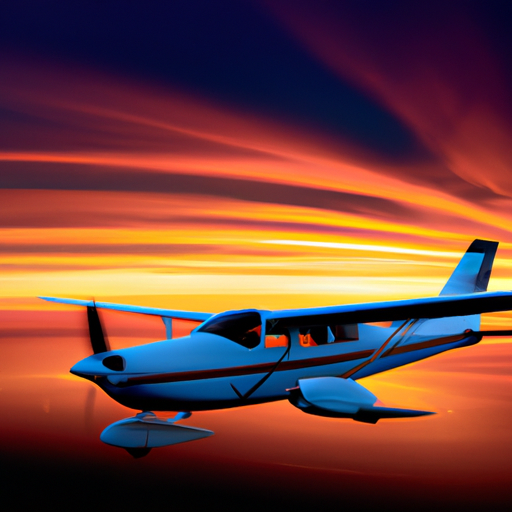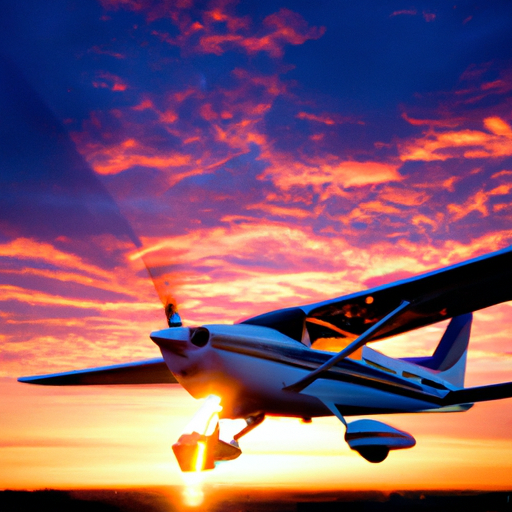
Do you ever wonder what those lights on a Cessna aircraft are for? You know, the ones that shine brightly in the night sky as a plane takes off or lands? Well, in this article, we’ll take a closer look at Cessna lights and explore their purpose and significance. By the end of this read, you’ll have a better understanding of the various lights you see on a Cessna and why they are essential for a safe and successful flight.
When it comes to Cessna lights, there are quite a few that serve different purposes. The most prominent ones you’ll notice are the navigation lights, located on the wingtips and tail of the aircraft. These lights are typically white or red, with the red light on the left (port) side and the green light on the right (starboard) side. Their role is to help pilots and other aircrafts determine the direction a Cessna is moving by observing the position of these lights. Additionally, there are anti-collision lights, which are usually a bright white strobe light that flashes at regular intervals. These lights are crucial for alerting other pilots in the vicinity of the Cessna’s presence in order to prevent collisions. So, as you can see, these lights are not just for aesthetics but serve a vital purpose in ensuring the safety of the aircraft and everyone onboard. To learn more about the different types of Cessna lights and their functions, read on in this informative article.

I. Introduction
A. Brief overview of Cessna Lights
Cessna Lights are an essential component of any Cessna aircraft, serving multiple purposes to ensure safety and compliance with aviation regulations. These lights play a crucial role in enhancing visibility during flight, preventing mid-air collisions, aiding in aircraft recognition, and complying with aviation regulations. In this article, we will explore the different types of Cessna Lights, their functions, and their importance in aviation.
II. Importance of Cessna Lights
A. Ensuring visibility during flight
One of the primary reasons why Cessna Lights are crucial is ensuring visibility during flight. These lights help the aircraft become easily noticeable to other pilots, air traffic controllers, and ground personnel. Whether it’s day or night, clear visibility is essential to avoid any potential accidents or encounters with other aircraft.
B. Enhancing safety measures
Cessna Lights play a significant role in enhancing safety measures. By providing adequate illumination to the aircraft, these lights help pilots navigate and ensure a safe takeoff, landing, and taxiing. They also aid in identifying potential obstacles or hazards in the aircraft’s path, preventing accidents and ensuring the overall safety of the flight.
C. Complying with aviation regulations
Cessna Lights are not just optional additions to the aircraft; they are mandatory for compliance with aviation regulations. Regulatory bodies have established specific requirements for the type, configuration, and operation of these lights to ensure uniformity and standardization across the aviation industry. Compliance with these regulations is necessary to maintain the airworthiness and legality of the aircraft.
III. Types of Cessna Lights
Cessna aircraft are equipped with various types of lights, each serving a specific purpose. Understanding the different types of Cessna Lights is essential for pilots, aircraft owners, and maintenance personnel. Let’s explore the most common types:
A. Navigation Lights
Navigation Lights, also known as position lights, are mounted on the wings and tail of the aircraft. These lights help other pilots determine the aircraft’s position and direction of travel. Typically, navigation lights consist of a red light on the left wingtip, a green light on the right wingtip, and a white light on the tail. This color combination is standardized and universally recognized in aviation.
B. Anti-Collision Lights
Anti-Collision Lights, commonly referred to as beacon lights, are primarily used to prevent mid-air collisions. These lights emit a bright, flashing pattern to make the aircraft highly visible to other aircraft and air traffic controllers. They are typically mounted on the top and bottom of the aircraft’s fuselage or tail. Anti-Collision Lights help avoid potential accidents by providing a clear indication of the aircraft’s presence in the airspace.
C. Landing Lights
Landing Lights are perhaps the most critical lights during takeoff and landing phases. These lights are mounted on the aircraft’s nose or wings and provide a powerful beam of light to illuminate the runway ahead. Landing Lights enhance visibility for the pilot, allowing them to see any obstacles or hazards on the runway during low-light conditions or inclement weather. They also serve as an indication to other aircraft that the aircraft is in the process of taking off or landing.
D. Taxi Lights
Taxi Lights are located on the nose or wings of the aircraft, facing forward, and are used specifically during taxiing. These lights provide illumination of the aircraft’s path on the ground, enabling the pilot to maneuver safely. Taxi Lights are particularly useful when operating in poorly lit areas, such as taxiways or remote airports. They help pilots identify any debris or obstacles that could pose a risk to the aircraft while it is moving on the ground.
E. Recognition Lights
Recognition Lights serve the purpose of visually identifying the aircraft. These lights are typically used during low visibility conditions, such as fog or heavy rain, to make the aircraft more distinguishable. They differ from navigation lights in that they are typically brighter and do not follow the standard red, green, and white color scheme. Recognition Lights are not always present on all Cessna aircraft, but they can be a valuable addition in certain flight conditions.

IV. Navigation Lights
A. Purpose and function
Navigation Lights are crucial for signaling the position and direction of the aircraft to other pilots and air traffic controllers. These lights provide a clear visual indication of whether the aircraft is approaching or moving away, as well as its orientation in relation to other aircraft.
B. Location and configuration
Navigation Lights are typically mounted on the wingtips and tail of the aircraft. The red light is positioned on the left wingtip, the green light on the right wingtip, and the white light on the aircraft’s tail. This configuration helps other pilots determine which direction the aircraft is traveling and its lateral position.
C. How they aid in aircraft visibility
Navigation Lights significantly enhance the visibility of the aircraft during flight. By following the standard red, green, and white color scheme, other pilots can quickly identify and track the aircraft’s movements. This aids in maintaining safe distances, avoiding mid-air collisions, and providing clear communication between pilots and air traffic controllers.
V. Anti-Collision Lights
A. Role in preventing mid-air collisions
Anti-Collision Lights are specifically designed to prevent mid-air collisions by making the aircraft highly visible in the sky. These lights emit a bright, flashing pattern that can be seen from a considerable distance. Other pilots and air traffic controllers can quickly identify the presence and position of the aircraft, allowing for timely course corrections or adjustments to maintain appropriate separation.
B. Different types and colors
Anti-Collision Lights come in various types and colors. The most common anti-collision lights are red or white strobe lights, which emit a bright, rapid flashing pattern. These lights are highly effective in attracting attention and alerting others to the aircraft’s presence. Some aircraft may also be equipped with rotating beacons, which emit a slower, steady beam of light.
C. Regulations and requirements
Regulatory bodies, such as the Federal Aviation Administration (FAA), have specific requirements for the operation and configuration of anti-collision lights. Compliance with these regulations is essential to ensure safety and maintain compliance. Pilots and aircraft operators must familiarize themselves with these regulations and ensure that their aircraft’s anti-collision lights meet the necessary standards.
VI. Landing Lights
A. Usage during takeoff and landing
Landing Lights play a crucial role during the takeoff and landing phases of flight. They provide a powerful beam of light that illuminates the runway ahead, allowing the pilot to see clearly and identify any potential hazards. These lights are typically turned on during the final approach and remain on until the aircraft has completed the landing or taken off.
B. Illumination range and intensity
Landing Lights are designed to have a significant illumination range, allowing the pilot to see far ahead during the critical phases of flight. The intensity of the light beam ensures that any obstacles, debris, or irregularities on the runway are easily visible. This enhances the pilot’s situational awareness and enables them to make informed decisions regarding the approach and landing.
C. Maintenance and inspections
Regular maintenance and inspections of landing lights are crucial to ensure their proper functioning. Pilots and aircraft owners must regularly check the lights for any signs of damage, including cracked lenses or loose connections. Replacing burnt-out bulbs and conducting routine inspections will ensure that the landing lights remain in optimal condition and provide the necessary illumination during critical phases of flight.
VII. Taxi Lights
A. Purpose and positioning
Taxi Lights serve the purpose of illuminating the aircraft’s path during taxiing on the ground. They help the pilot see clearly and identify potential hazards or obstructions on the taxiway or ramp. Taxi Lights are typically positioned on the nose or wings of the aircraft, facing forward, to provide the best possible illumination of the aircraft’s path.
B. Enhancing visibility on the ground
Taxi Lights significantly enhance visibility on the ground, particularly in poorly lit areas or during nighttime operations. By illuminating the aircraft’s path, pilots can identify any debris, potholes, or other obstacles that could pose a risk to the aircraft or impede its movement. This ensures safe and efficient taxiing from the gate to the runway and vice versa.
C. Function during taxiing
Taxi Lights are turned on as the aircraft begins its taxi from the gate or parking area. They remain on until the aircraft reaches the runway or designated parking spot. During taxiing, these lights illuminate the taxiway, allowing the pilot to follow the designated route and maintain safe clearance from other aircraft and ground vehicles.
VIII. Recognition Lights
A. Providing visual identification
Recognition Lights serve the purpose of providing visual identification to the aircraft. These lights are particularly useful during low visibility conditions or situations where clear aircraft recognition is essential, such as in the vicinity of military airbases or during emergency operations. Recognition Lights are brighter than navigation lights and are often configured to emit a unique pattern or color.
B. Differentiation from navigation lights
Although Recognition Lights share some similarities with navigation lights, they serve a different purpose. While navigation lights indicate the aircraft’s position and direction of travel, recognition lights are primarily focused on making the aircraft easily distinguishable and identifiable. These lights are not mandatory on all aircraft but can be valuable additions in certain operational scenarios.
C. Situations where they are utilized
Recognition Lights are utilized in various situations, including military operations, law enforcement operations, and emergency services. For example, military aircraft may use recognition lights to differentiate themselves from civilian aircraft during training exercises or in combat zones. Similarly, law enforcement aircraft may use recognition lights to distinguish themselves during surveillance or rescue operations. These lights help prevent confusion and enhance cooperation between different entities operating in the same airspace.
IX. Considerations for Cessna Light Maintenance
A. Regular inspections and replacements
Regular inspections and replacements are essential for maintaining the proper functioning of Cessna Lights. Pilots and maintenance personnel should conduct routine checks to ensure that all lights are free from damage, such as cracked lenses or loose connections. Burnt-out bulbs should be replaced promptly to maintain optimal visibility and compliance with regulations.
B. Cleaning and upkeep procedures
Proper cleaning and upkeep procedures are vital to ensure that Cessna Lights remain in optimal condition. Regularly cleaning the lenses with a mild detergent and non-abrasive cloth can help remove dust, dirt, and debris that may accumulate over time. Additionally, inspecting the wiring and connections for any signs of wear or corrosion can prevent potential malfunctions or electrical issues.
C. Troubleshooting and common issues
Troubleshooting and addressing common issues with Cessna Lights are essential for maintaining optimal performance. In case of light failures or irregularities, pilots and maintenance personnel should consult the aircraft’s maintenance manual and follow the recommended troubleshooting procedures. Common issues may include bulb replacements, wiring repairs, or addressing electrical faults.
X. Conclusion
A. Recap of the importance of Cessna Lights
Cessna Lights are crucial for ensuring visibility, enhancing safety measures, and complying with aviation regulations. From navigation lights to anti-collision lights, landing lights, taxi lights, and recognition lights, each serves a specific purpose to contribute to a safe and efficient flight.
B. Encouragement to prioritize maintenance and compliance
To maintain the effectiveness of Cessna Lights, regular maintenance, inspections, and compliance with aviation regulations are essential. Pilots and aircraft owners should prioritize the upkeep of these lights to ensure optimal performance and contribute to overall aviation safety.
By understanding the functions and importance of Cessna Lights, pilots and aircraft owners can contribute to a safer and more efficient aviation environment. Prioritizing proper maintenance and compliance will ensure that these lights continue to serve their crucial role in enhancing visibility, preventing collisions, and making aircraft easily identifiable in the sky.


Leave a Reply